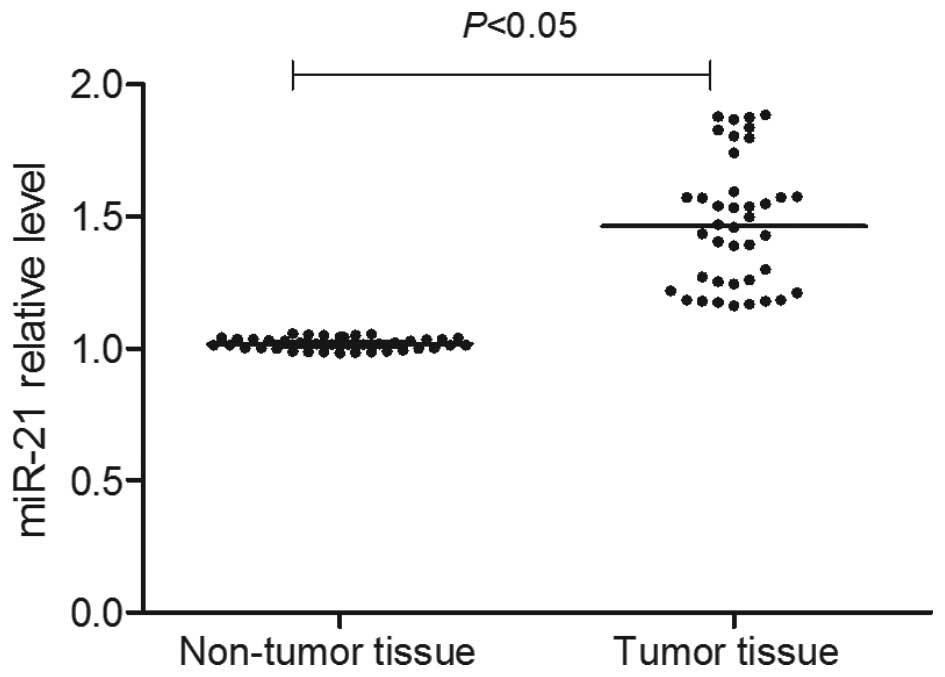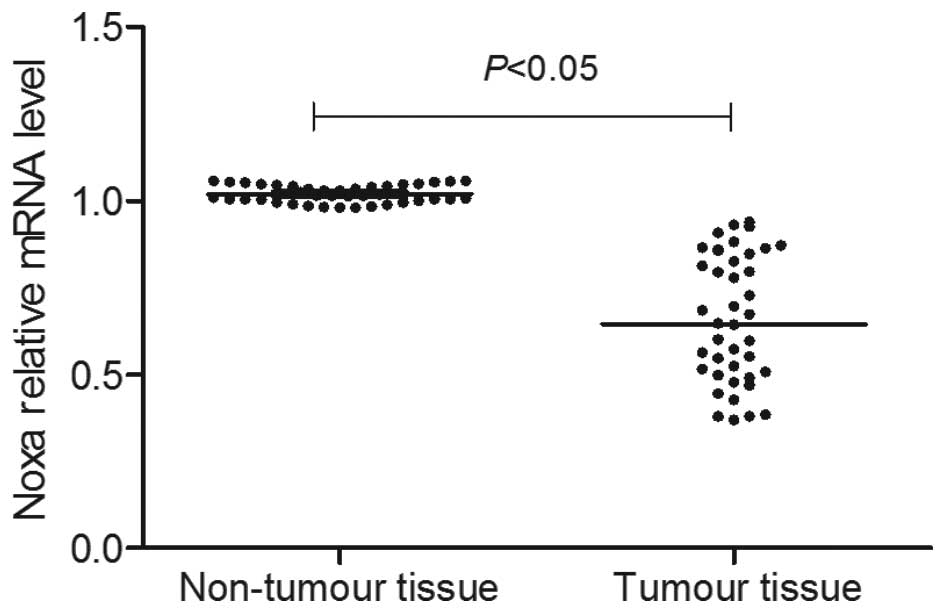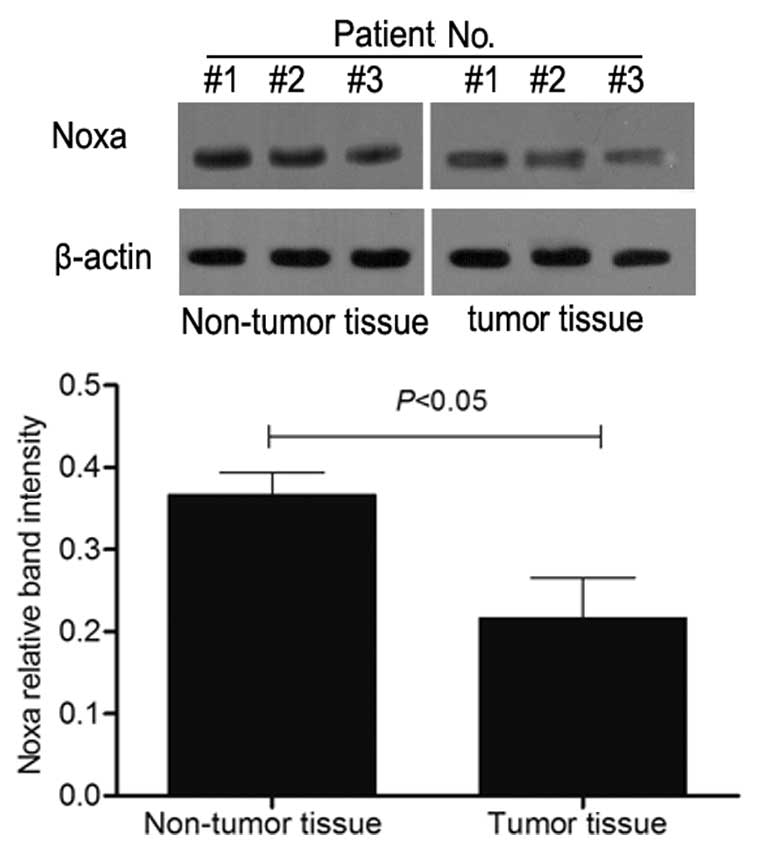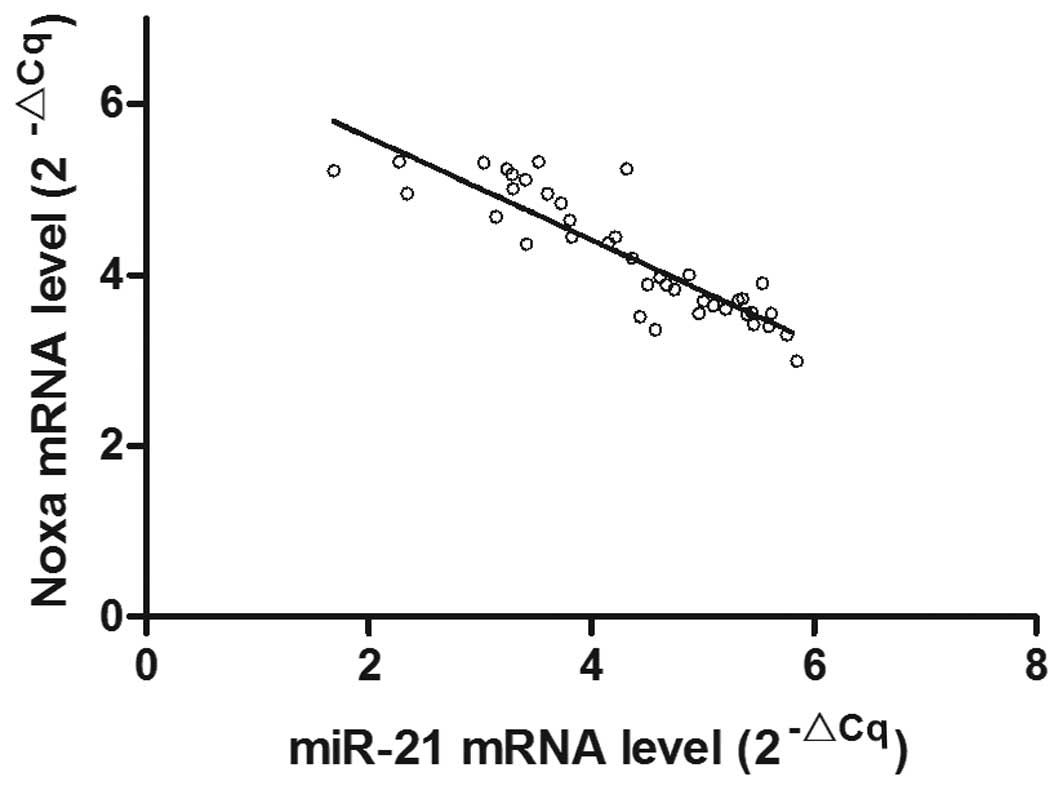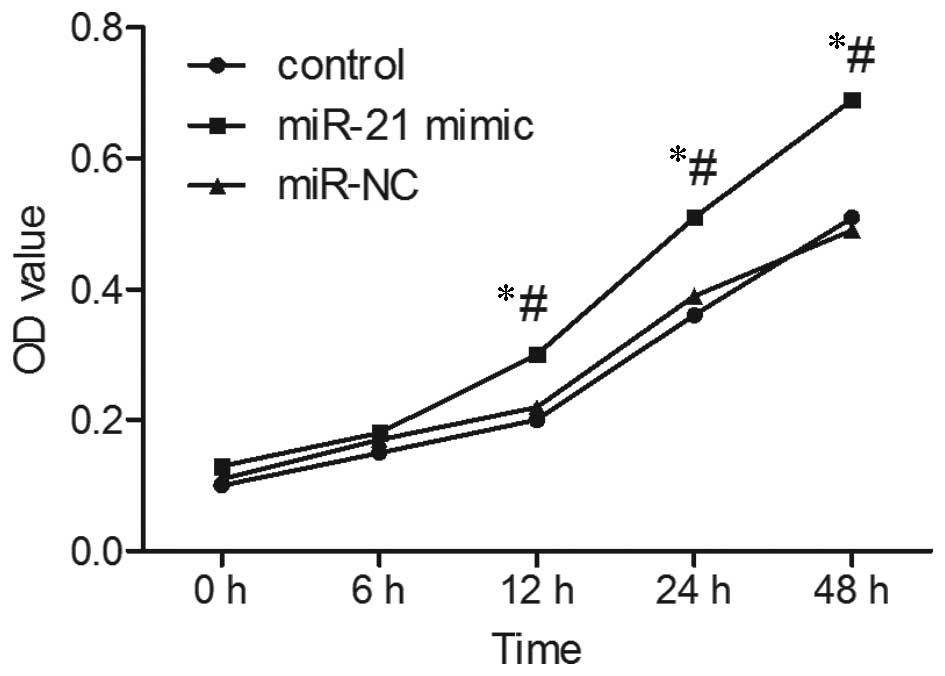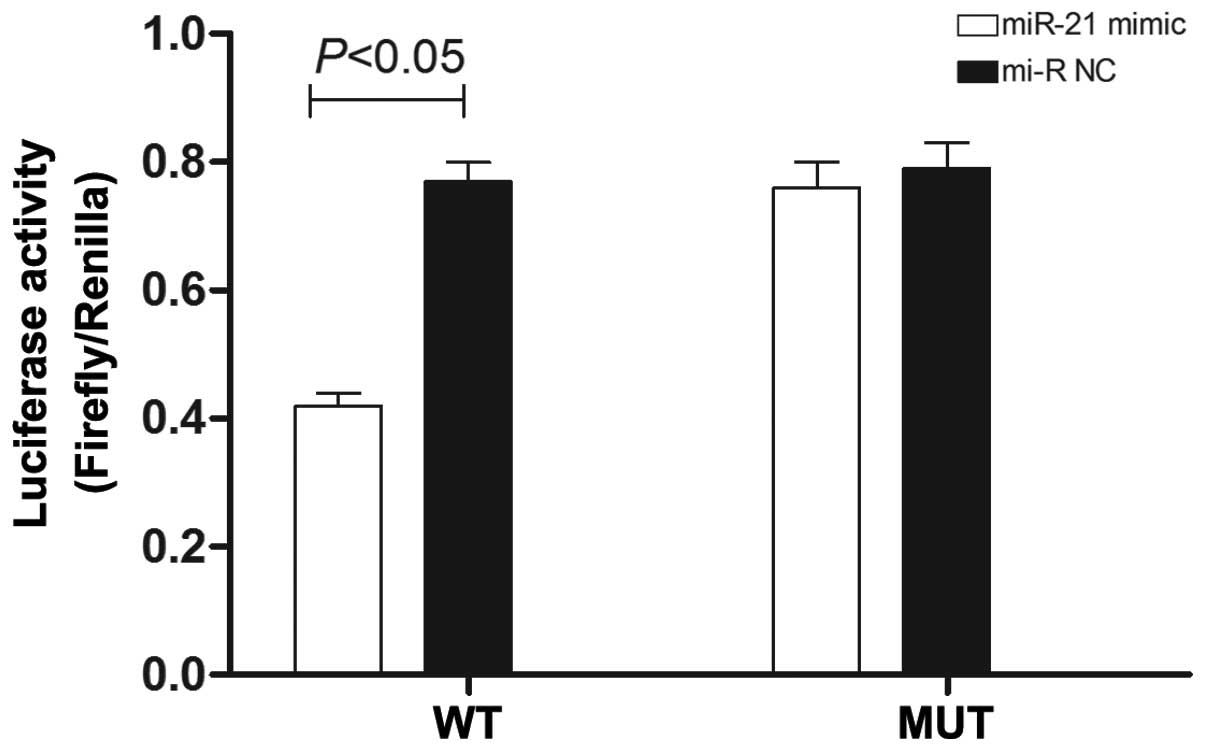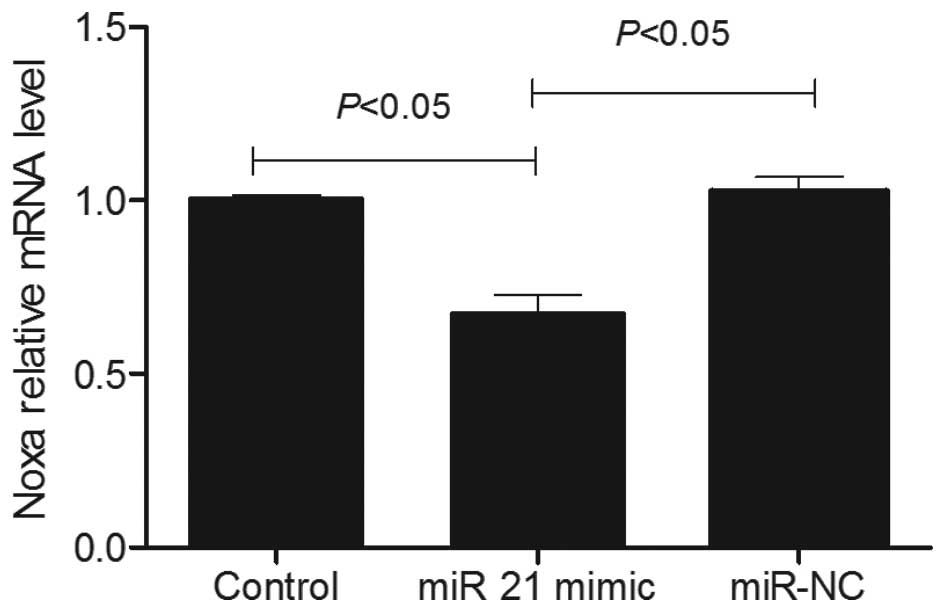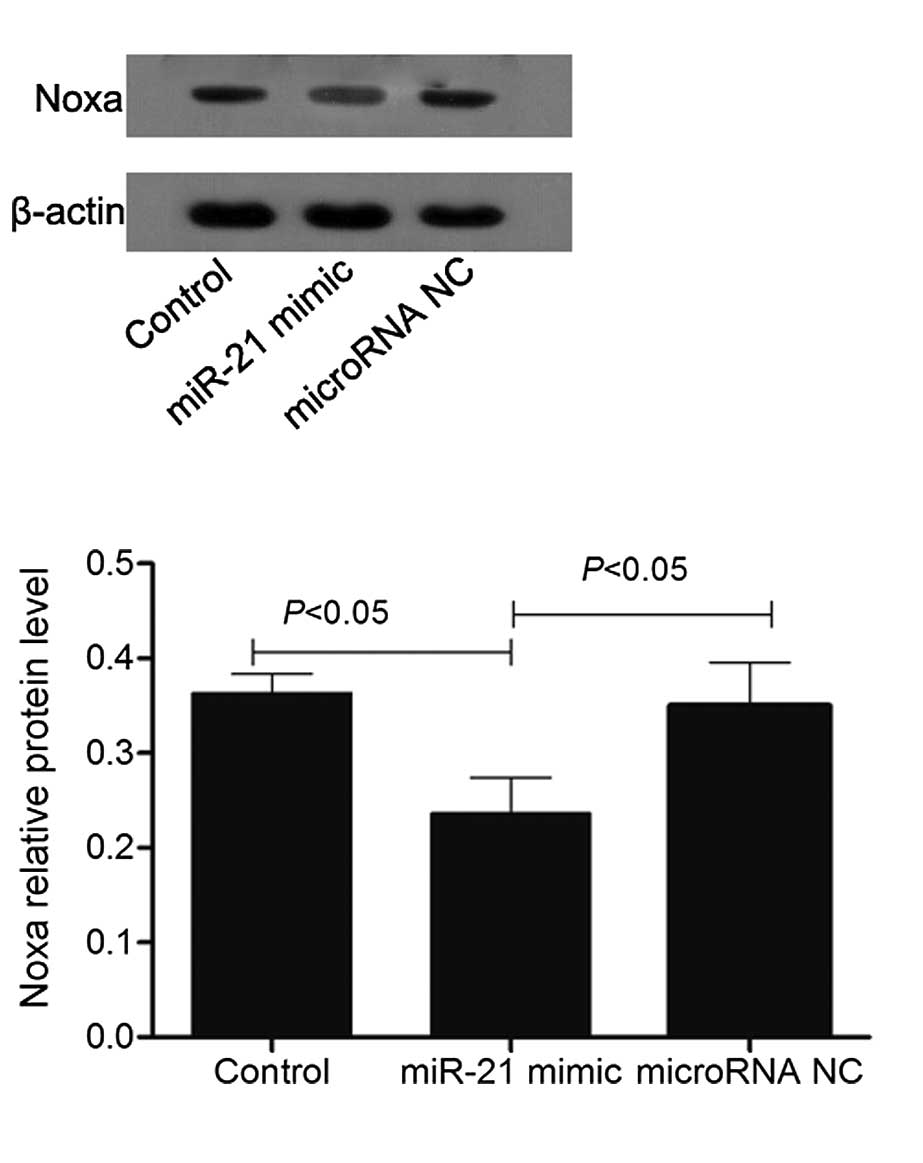MicroRNA‑21 expression is associated with the clinical features of patients with gastric carcinoma and affects the proliferation, invasion and migration of gastric cancer cells by regulating Noxa
- Authors:
- Published online on: February 4, 2016 https://doi.org/10.3892/mmr.2016.4863
- Pages: 2701-2707
Abstract
Introduction
Gastric cancer is a common type of gastrointestinal cancer worldwide (1). In China, the incidence of gastric cancer is the highest of the digestive system neoplasms and second for all malignant tumors (2). Recent studies have observed that there are ~500,000 diagnoses of gastric cancer in China every year, accounting for ~50% of diagnoses worldwide. Furthermore, stomach cancer results in 10% of cancer-associated mortalities (3). Investigations into the association between microRNA (miR) and stomach cancer have increased. miRs are a class of non-coding RNA 18–21 nt in length. They are highly expressed in eukaryotic cells, and contribute to the regulation of cell growth, development and apoptosis (4,5). Numerous studies have shown that the occurrence and progression of tumors is accompanied by an abnormal change in miR expression levels (6,7). A number of studies have demonstrated increased expression levels of miR-21 in various solid tumors, for example, Volinia et al (8) observed that miR-21 was upregulated in breast and lung cancer, and was associated with a poor prognosis. However, the association between miR-21 expression and gastric cancer proliferation, invasion and migration has not been widely investigated, and the underlying mechanism of the potential target protein miR-21 remains to be elucidated. The present study aimed to validate the association between miR-21 and the clinical features of patients with gastric cancer, as well as the proliferation, invasion and migration of gastric cancer cells by analyzing samples of gastric cancer tissues and the results of in vitro cellular experiments. Bioinformatics and dual luciferase report analysis in the SGC-7901 gastric cancer cell line was performed in the current study and demonstrated that Noxa, a member of the B-cell lymphoma 2 (Bcl-2) family with pro-apoptotic effects (9–11) is the target gene of miR-21.
Materials and methods
Clinical data of patients
Paraffin-embedded tissue samples were collected from 40 patients, who had undergone radical resection for gastric cancer in the Fifth Affiliated Hospital of Zhengzhou University (Zhengzhou, China) between January 2012 and May 2014. Patients included 22 males and 18 females, with a median age of 60 years (range, 43–76 years). All patients were diagnosed by endoscopy and pathology. In eight cases the tumor size was <3 cm, in 10 cases the tumor size was 3–5 cm, and in 22 cases the tumor size was ≥5 cm; 24 cases were intestinal-type and 16 cases were diffuse-type. There were 14 cases with lymph node metastasis, and 26 cases without lymph node metastasis. TNM staging was conducted (12) and 7 cases were stage I, 9 cases were stage II, 18 cases were stage III and 6 cases were stage IV (Table I). The patients had not received preoperative chemotherapy or radiotherapy. The present study was approved by the ethics committee of the Fifth Affiliated Hospital of Zhengzhou University (Zhengzhou, China).
Table IAssociation between miR-21 expression and pathological characteristics of patients with gastric cancer. |
Detection of miR-21 in tissue samples
The miR was extracted and purified from cancer tissues and matched adjacent non-tumor tissues of the 40 patients using a paraffin-embedded tissue microRNA rapid extraction kit (Beijing Bioteke Biotechnology Co., Ltd., Beijing, China) according to the manufacturer's protocols. In brief, tissue samples were treated with dimethylbenzene to remove the paraffin and then guanidinium isothiocyanate was added for tissue lysis. Lysates were treated with chloroform and centrifuged at 12,000 × g for 15 min according to the manufacturer's instructions of the protein extract kit (Thermo Fisher Scientific, Inc., Waltham, MA, USA). miRNA products were purified using a silicon substrate membrane adsorption column from the extraction kit. Reverse transcription (RT) of miR into cDNA was performed using a One Step PrimeScript miRNA cDNA Synthesis kit (Takara Biotechnology, Co., Ltd., Dalian, China) according to the manufacturer's protocols. For each sample, 2 µg miR was reverse transcribed in the reaction system, including miR reaction buffer mix (containing oligodt and RT primers miRNA) and PrimeScript® RT enzyme mix (containing poly(A) polymerase and reverse transcriptase). For setting the RT− control, the same system was used, however, water was used to replace miR. The reaction conditions were as follows: 60 min poly(A) polymerase reaction and reverse transcription at 37°C and 5 sec at 85°C for inactivating the enzymes. The cDNA was amplified by RT quantitative polymerase chain reaction (qPCR) with the SYBR® Premix Ex Taq™ II kit (Takara Biotechnology, Co., Ltd.) according to the manufacturer's protocols. The primers were as follows: Sense, 5′-GCCGCTAGCTTATCAGACTGATGT-3′ for miR-21; and sense, 5′-CTCGCTTCGGCAGCACA-3′ for U6 snRNA, which was used to normalize the data. The antisense primer, Uni-miR qPCR, was obtained from the One Step PrimeScript miRNA cDNA Synthesis kit. The relative expression level of miR-21 was expressed by 2−ΔΔCq (for tumor tissue/non-tumor tissues), where 2−ΔΔCq=Cq (target)-Cq (U6 snRNA) (13).
Detection of Noxa expression levels in tissue samples
The total RNA of tumor and non-tumor tissues was extracted using TRIzol® (Thermo Fisher Scientific, Inc.), and RT of miR into cDNA was performed using the GoScript Reverse Transcription kit [Promega (Beijing) Biotech Co., Ltd., Beijing, China] according to the manufacturer's protocols. Fluorescent RT-qPCR was implemented using a GoTaq® qPCR kit [Promega (Beijing) Biotech Co., Ltd.] according to the manufacturer's protocols. Primers used were as follows: Sense, 5′-TTCGTGTTCAGCTCGCGTCC-3′ and antisense, 5′-CTCGGTGTAGCCTTCTTGCC-3′ for Noxa; and sense, 5′-ACCACAGTCCATGCCATCAC-3′ and antisense, 5′-TCCACCACCCTGTTGCTGTA-3′ for GAPDH, which was used to normalize the data. The relative expression level of Noxa was expressed by 2−ΔΔCq (for tumor tissue / non-tumor tissue).
Total protein of the tissue sample was extracted by radioimmunoprecipitation assay (RIPA) lysis buffer (Thermo Fisher Scientific, Inc.) containing 1% protease inhibitor cocktail (500 µl/well; Thermo Fisher Scientific, Inc.). Electrophoresis was performed with 12% polyacrylamide gel (Applygen Technologies Inc., Beijing, China) at 100 V for 1.5 h and for each sample, 45 µg protein was loaded onto each lane. Following electrophoresis, the protein bands were transferred to a polyvinylidene fluoride membrane (Applygen Technologies, Inc.) with a 200-mA constant current for 1.5 h. The membranes were blocked for 1 h with 5% skimmed milk powder at room temperature prior to incubation with mouse monoclonal anti-human Noxa antibody (1:500; Santa Cruz Biotechnology, Inc., Dallas, TX, USA; cat. no. sc-398873) and mouse monoclonal anti-human β-actin antibody (1:1,000; Santa Cruz Biotechnology, Inc.; cat. no. sc-47778) at 4°C overnight. The membranes were washed three times with phosphate-buffered saline with Tween-20 (Applygen Technologies, Inc.) to remove excess antibodies, and the horseradish peroxidase-labeled goat anti-mouse IgG (1:500; Santa Cruz Biotechnology, Inc; cat. no. sc-2005) secondary antibody was added and incubated for 2 h at room temperature. The membranes were washed to remove excess antibodies and color development of bands was visualized using an enhanced chemiluminescence color development kit (Applygen Technologies, Inc.), and the Noxa protein band intensity was analyzed using the BandScan system (Tanon 5200 Image Analysis System; Tanon Science & Technology Co., Ltd., Shanghai, China).
Culture of the SGC-7901 gastric cancer cell line
The SGC-7901 human gastric cell line was purchased from the cell bank of the Shanghai Institute of Biochemistry and Cell Biology (Chinese Academy of Sciences, Shanghai, China). Dulbecco's modified Eagle's medium (DMEM; Thermo Fisher Scientific, Inc.) containing 10% fetal bovine serum (FBS; Thermo Fisher Scientific, Inc.) was used for cell culture and 0.25% trypsin (Thermo Fisher Scientific, Inc.) was used for cell digestion. Cells were cultured at 37°C in 5% CO2 for 24–48 h.
Upregulation of miR-21
miR-21 mimics were designed and synthesized by Shanghai GenePharma Co., Ltd. (Shanghai, China). SGC-7901 cells in the logarithmic growth phase were transfected with the miR-21 mimic and the miR-negative control (NC) using a Lipofectamine™ 2000 transfection kit (Thermo Fisher Scientific, Inc.). The transfection was conducted according to the manufacturer's protocol. Overexpression of miR-21 was verified using RT-qPCR 48 h following transfection.
Effect of miR-21 upregulation on SGC-7901 cell proliferation and the cell cycle
The non-transfected (control), miR-21 mimic-transfected and miR-NC-transfected SGC-7901 cells were maintained in 96-well plates at a density of 1×104/well for 6, 12, 24 or 48 h. MTT reagent (10 µl) was added to each well, and after 4 h, DMSO (100 µl) was added to each well. The optical density (OD) values at 490 nm were determined using a microplate reader (UV/Vis Absorbance Spectra; BMG Labtech, Ltd., Cary, NC, USA). For cell cycle analysis, transfected and non-transfected cells were fixed in cold 70% ethanol and stained with 50 µg/ml propidium iodide (Sigma-Aldrich, St. Louis, MO, USA) and incubated for 30 min at room temperature. Analysis was performed using a BD FACSCalibur flow cytometer (Becton, Dickinson and Company, San Jose, CA, USA) within 15 min after incubation. CellQuest software (version 5.1; Becton, Dickinson and Company) was used to analyze the cell cycle and apoptosis rate.
Effect of miR-21 upregulation on SGC-7901 cell migration and invasion
The non-transfected (control), miR-21 mimic-transfected and miR-NC-transfected SGC-7901 cells were cultured in an uncoated Transwell chamber at a density of 1×105/well in the upper layer (membrane pore size, 8 µm) to detect the migration of cells. The above-mentioned cells were also cultivated in a Matrigel-coated Transwell chamber (Corning Inc., Corning, NY, USA) in the upper layer (membrane pore size, 8 µm) to detect the invasive ability of the cells. The serum-free DMEM medium was used for the upper chamber and the medium containing 10% FBS was placed in the lower chamber. Following culture for 6 h, the cells that had remained in the upper chamber were removed, and the number of cells that had migrated or invaded the lower layer was estimated using Giemsa (Applygen Technologies, Inc.) staining.
Prediction and verification of miR-21 targets
The target gene of miR-21 was predicted using the bioinformatics prediction software, PicTar (http://pictar.mdc-berlin.de/) and TargetScan5.0 (Whitehead Institute for Biomedical Research, Cambridge, MA, USA). Following integration of the results from the software, the candidate target genes were further confirmed by the dual luciferase reporting system. Shanghai Sangong Pharmaceutical Co., Ltd. (Shanghai, China) designed and constructed the luciferase reporter plasmid containing wild-type Noxa 3′-untranslated region (UTR) and mutant Noxa 3′-UTR, designated pMIR-Noxa-wild and pMIR-Noxa-mut, respectively. The SGC-7901 cells were divided into four groups as follows: miR-21 mimic + pMIR-Noxa-wild; miR-NC + pMIR-Noxa-wild; miR-21 mimic + pMIR-Noxa-mut; and miR-NC + pMIR-Noxa-wild. Following transfection, cells were cultivated in 96-well plates at a density of 1×104/well and cultured for 48 h, prior to the addition of 100 µl lysis buffer (Applygen Technologies, Inc.) to each well. The supernatant was collected following lysis, and 10 µl of supernatant was added to the 40 µl firefly luciferase substrate and mixed evenly for 15 sec prior to determining the fluorescence intensity. The remaining supernatant was added to 40 µl Renilla luciferase substrate, and mixed evenly before determining the fluorescence intensity. The ratio of firefly to Renilla luciferase intensity was calculated to demonstrate the effect of miR-21 on the expression level of Noxa mRNA.
Effect of miR-21 overexpression on Noxa expression levels
The total RNA of non-transfected, miR-21 mimic-transfected and miR-NC-transfected SGC-7901 cells was extracted using TRIzol®. The RT of miR into cDNA was performed using the GoScript Reverse Transcription kit [Promega (Beijing) Biotech Co., Ltd.] according to the manufacturer's protocols. Fluorescent RT-qPCR was implemented using a GoTaq® qPCR kit according to the manufacturer's protocols. The sequence of the primers for Noxa was as described above. The total protein in the cells was extracted using RIPA lysis buffer (500 µl/well) containing 1% protease inhibitor cocktail. The effect of miR-21 upregulation on Noxa protein expression levels was detected by western blotting, following the above-mentioned procedure.
Statistical analysis
Statistical analysis was performed using SPSS 13.0 statistical software (SPSS, Inc., Chicago, IL, USA). The normality data are expressed as means ± standard deviation and the non-normal data are expressed as medians. Data were compared between two or multiple groups using Student's t-test and one-way analysis of variance, respectively. The non-parametric test was performed by Mann-Whitney rank-sum test and χ2 test. P<0.05 was considered to indicate a statistically significant difference.
Results
Increased expression levels of miR-21 in gastric cancer tissue are associated with the clinical features of gastric cancer
As presented in Fig. 1, RT-qPCR detection demonstrated that the miR-21 expression level in the cancer tissue was significantly increased (P<0.05). Using the median of the miR-21 expression levels (2−ΔΔCq) in gastric cancer tissue as the limit, all patients with gastric cancer were divided into an miR-21 high expression group [2−ΔΔCq (miR-21)≥4.23] and an miR-21 low expression group [2−ΔΔCq (miR-21)<4.23]. Analysis of the association between the clinical features of patients (gender, age, tumor size, histological type, lymph node metastasis and TNM staging), and the level of miR-21 expression (Table I) demonstrated that the expression level of miR-21 was not associated with the patient's age, gender, and histological type (P>0.05); however was associated with the tumor size, TNM stage and presence of lymph node metastasis (P<0.05). Univariate analysis demonstrated that increased expression levels of miR-21 were associated with larger tumor size [diameter, >5 cm; odds ratio (OR), 5.34; 95% confidence interval (CI), 1.35–21.15; P<0.05], high TNM stage (stage III and IV; OR, 5.00; 95% CI, 1.27–19.68; P<0.05), and the emergence of lymph node metastasis (OR, 8.33; 95% CI, 1.90–6.44; P<0.05).
Expression levels of Noxa in gastric cancer tissue were decreased and negatively correlated with the expression level of miR-21
As presented in Fig. 2, RT-qPCR detection demonstrated that the mRNA level of Noxa in tumor tissue was significantly lower than that of the adjacent non-tumor tissue samples (P<0.05). Consistent with the RT-qPCR results, the western blot analysis indicated that the Noxa protein expression level in the tumor tissue was decreased (Fig. 3). The correlation analysis (Fig. 4) demonstrated that the mRNA expression level of Noxa in the gastric cancer tissue samples was inversely proportional to the level of miR-21 mRNA expression (r=−0.782; P<0.05).
Upregulation of miR-21 promotes growth of SGC-7901 cells
As presented in Fig. 5, MTT analysis indicated that following upregulation of miR-21, the rate of proliferation of SGC-7901 cells was significantly increased. Following culture for 12 and 48 h, the OD value of SGC-7901 cells following upregulation of miR-21 was significantly higher than that of the non-transfected (control) and miR-NC-transfected SGC-7901 cells (P<0.05). Cell cycle analysis revealed that following transfection of the miR-21 mimic, the ratio of G0/G1 of SGC-7901 cells decreased, while the proportion of cells in the S phase increased, indicating active DNA synthesis in the cells (Fig. 6).
Increased expression levels of miR-21 promoted the migration and invasion of SGC-7901 cells
As presented in Fig. 7, the Transwell chamber culture analysis demonstrated that, compared with the non-transfected SGC-7901 cells and SGC-7901 cells transfected with miR-NC, the SGC-7901 cells transfected with miR-21 mimic exhibited marked migration and invasion.
Noxa is a potential target of miR-21
The analysis results using PicTar and TargetScan5.0 software indicated that the microRNA gene binding free energy of the Noxa gene binding with miR-21 was lower than other potential miR-21-targeted mRNAs, indicating that miR-21 can easily bind with Noxa, and thus Noxa may be a target of miR-21. The complementary base pairing existed between seven bases of miR-21 and the 3′-UTR. Thus, the Noxa gene may be a potential target gene of miR-21. The dual luciferase report analysis (Fig. 8) demonstrated that the fluorescence intensity of SGC-7901 cells transfected with miR-21 mimic + pMIR-Noxa-wild was significantly lower than that of the cells transfected with miR-NC + pMIR-Noxa-wild (P<0.05). The fluorescence value of SGC-7901 cells transfected with miR-21 mimic + pMIR-Noxa-mut was not decreased significantly compared with the cells transfected with miR-NC + pMIR-Noxa-mut, suggesting that miR-21 may exert an inhibitory effect by functioning at the 3′-UTR region of Noxa. RT-qPCR and western blotting (Figs. 9 and 10) confirmed that Noxa may be a target gene of miR-21.
Overexpression of miR-21 reduced the expression levels of Noxa
As presented in Fig. 9, RT-qPCR analysis demonstrated that the mRNA level of Noxa in SGC-7901 cells transfected with the miR-21 mimic was decreased compared with the non-transfected SGC-7901 cells and SGC-7901 cells transfected with miR NC. It was decreased by 0.63±0.03-fold vs. the non-transfected SGC-7901 cells (P<0.05). The results of the western blot analysis were consistent with those of the RT-qPCR, demonstrating that an increased level of miR-21 augments the expression level of Noxa protein in SGC-7901 cells (Fig. 10).
Discussion
miRs have wide-ranging applications as tumor biomarkers. However, the association between miRs and tumorigenesis, metastasis and infiltration, as well as the underlying mechanisms, requires further investigation. miR-21 is present in a variety of solid tumors. Numerous studies have demonstrated increased expression levels of miR-21 in breast, hepatocellular, lung, pancreatic and ovarian cancer, and glioma (14,15). Furthermore, increased expression levels of miR-21 are associated with poor patient prognosis (16–19). In the present study, the change of miR-21 expression level in patients with gastric cancer was analyzed. The tissue sample analysis demonstrated that the expression level of miR-21 in the cancer tissue samples was significantly increased compared with that of non-tumor tissue samples. Further analysis also indicated that the expression level of miR-21 was associated with the clinical features of patients with gastric cancer; for example, the miR-21 expression level of patients at an advanced TNM stage and patients with lymph node metastasis was increased. Following upregulation of miR-21, SGC-7901 proliferation was observed to accelerate. In addition, the cell cycle analysis indicated an increased proportion of cells in S phase with greater invasion and migration capability.
Noxa is a member of the Bcl-2 family, which is located in the mitochondrial membrane and exerts pro-apoptotic effects (20,21). Its mechanism of pro-apoptosis is associated with the mitochondrial cytochrome c signaling pathway. Noxa increases the permeability of the mitochondrial membrane, promoting the release of cytochrome c (9,10). It is a downstream gene of p53 and when cells are damaged following stimulation, p53 binds with the upstream promoter sequence of Noxa to enhance expression levels. Thus, the pro-apoptotic effects of Noxa are dependent on p53 (22–24). In tumor cells, Noxa expression levels decrease, which may affect tumor cell apoptosis and reduce the effect of therapeutic agents (25). For example, Kuwahara et al (26) found that decreased Noxa expression levels may result in decreased sensitivity to chemotherapeutic agents in malignant rhabdoid tumor. Ehrhardt et al (27) observed that following p53 and Noxa gene knockout, apoptosis of acute lymphoblastic leukemia, induced by conventional cytotoxic therapeutic agents combined with betulinic acid, decreased. Consistent with these previous findings, decreased expression levels of Noxa were observed in gastric cancer tissue samples in the present study. In addition, Noxa expression levels in gastric cancer patients were observed to be negatively correlated with the miR-21 expression level. The bioinformatics software and dual luciferase reporter enzymes indicated that Noxa is the target gene of miR-21 and upregulation of miR-21 in SGC-7901 cells reduced the Noxa expression levels. Therefore, miR-21 and Noxa may serve as targets for the treatment of gastric cancer. However, the present study did not clarify the effect of variations in the expression level of Noxa on the gastric cancer cells, which requires further investigation.
In conclusion, miR-21 affects the proliferation, invasion and migration of gastric cancer cells via Noxa. Increased expression levels of miR-21 and decreased expression levels of Noxa decreases apoptosis of tumor cells and results in a poor prognosis for gastric cancer patients.
References
|
Ferro A, Peleteiro B, Malvezzi M, Bosetti C, Bertuccio P, Levi F, Negri E, La Vecchia C and Lunet N: Worldwide trends in gastric cancer mortality (1980–2011), with predictions to 2015, and incidence by subtype. Eur J Cancer. 50:1330–1344. 2014. View Article : Google Scholar : PubMed/NCBI | |
|
Ding YB, Xia TS, Wu JD, Chen GY, Wang S and Xia JG: Surgical outcomes for gastric cancer of a single institute in southeast China. Am J Surg. 203:217–221. 2012. View Article : Google Scholar | |
|
Wang R and Chen XZ: High mortality from hepatic, gastric and esophageal cancers in mainland China: 40 years of experience and development. Clin Res Hepatol Gastroenterol. 38:751–756. 2014. View Article : Google Scholar : PubMed/NCBI | |
|
Bhattacharyya M, Nath J and Bandyopadhyay S: MicroRNA signatures highlight new breast cancer subtypes. Gene. 556:192–198. 2015. View Article : Google Scholar | |
|
Rane JK, Scaravilli M, Ylipää A, Pellacani D, Mann VM, Simms MS, Nykter M, Collins AT, Visakorpi T and Maitland NJ: MicroRNA expression profile of primary prostate cancer stem cells as a source of biomarkers and therapeutic targets. Eur Urol. 67:7–10. 2015. View Article : Google Scholar | |
|
Xue Z, Wen J, Chu X and Xue X: A microRNA gene signature for identification of lung cancer. Surg Oncol. 23:126–131. 2014. View Article : Google Scholar : PubMed/NCBI | |
|
Yu J, Feng J, Zhi X, Tang J, Li Z, Xu Y, Yang L, Hu Z and Xu Z: Let-7b inhibits cell proliferation, migration, and invasion through targeting Cthrc1 in gastric cancer. Tumour Biol. 36:3221–3229. 2015. View Article : Google Scholar | |
|
Volinia S, Nuovo G, Drusco A, Costinean S, Abujarour R, Desponts C, Garofalo M, Baffa R, Aeqilan R, Maharry K, et al: Pluripotent stem cell miRNAs and metastasis in invasive breast cancer. J Natl Cancer Inst. 106:1062014. View Article : Google Scholar | |
|
Rudner J, Elsaesser SJ, Müller AC, Belka C and Jendrossek V: Differential effects of anti-apoptotic Bcl-2 family members Mcl-1, Bcl-2, and Bcl-xL on celecoxib-induced apoptosis. Biochem Pharmac. 79:10–20. 2010. View Article : Google Scholar | |
|
Aikawa T, Shinzawa K, Tanaka N and Tsujimoto Y: Noxa is necessary for hydrogen peroxide-induced caspase-dependent cell death. FEBS Lett. 584:681–688. 2010. View Article : Google Scholar : PubMed/NCBI | |
|
Cheng EHYA, Wei MC, Weiler S, Flavell RA, Mak TW and Lindsten T: BCL-2, BCL-X(L) sequester BH3 domain-only molecules preventing BAX- and BAK-mediated mitochondrial apoptosis. Mol Cell. 8:705–711. 2001. View Article : Google Scholar : PubMed/NCBI | |
|
Sobin LH, Gospodarowicz MK and Wittekind C: TNM Classification of Malignant Tumors. 7th Edition. Wiley-Blackwell; Oxford: 2010 | |
|
Livak KJ and Schmittgen TD: Analysis of relative gene expression data using real-time quantitative PCR and the 2(-Delta Delta C(T)) Method. Methods. 25:402–408. 2001. View Article : Google Scholar | |
|
Hong L, Han Y, Zhang Y, Zhang H, Zhao Q, Wu K and Fan D: MicroRNA-21: A therapeutic target for reversing drug resistance in cancer. Expert Opin Ther Targets. 17:1073–1080. 2013. View Article : Google Scholar : PubMed/NCBI | |
|
Wang Z, Han J, Cui Y, Fan K and Zhou X: Circulating microRNA-21 as noninvasive predictive biomarker for response in cancer immunotherapy. Med Hypotheses. 81:41–43. 2013. View Article : Google Scholar : PubMed/NCBI | |
|
Halimi M, Parsian H, Asghari SM, Sariri R, Moslemi D, Yeganeh F and Zabihi E: Clinical translation of human microRNA 21 as a potential biomarker for exposure to ionizing radiation. Transl Res. 163:578–584. 2014. View Article : Google Scholar : PubMed/NCBI | |
|
Mace TA, Collins AL, Wojcik SE, Croce CM, Lesinski GB and Bloomston M: Hypoxia induces the overexpression of microRNA-21 in pancreatic cancer cells. J Surg Res. 184:855–860. 2013. View Article : Google Scholar : PubMed/NCBI | |
|
Tomimaru Y, Eguchi H, Nagano H, Wada H, Kobayashi S, Marubashi S, Tanemura M, Tomokuni A, Takemasa I, Umeshita K, et al: Circulating microRNA-21 as a novel biomarker for hepatocellular carcinoma. Journal of Hepatology. 56:167–175. 2012. View Article : Google Scholar | |
|
Wang ZX, Lu BB, Wang H, Cheng ZX and Yin YM: MicroRNA-21 modulates chemosensitivity of breast cancer cells to doxorubicin by targeting PTEN. Arch Med Res. 42:281–290. 2011. View Article : Google Scholar : PubMed/NCBI | |
|
Hsu CC, Wu YC, Farh L, Du YC, Tseng WK, Wu CC and Chang FR: Physalin B from Physalis angulata triggers the NOXA-related apoptosis pathway of human melanoma A375 cells. Food Chem Toxicol. 50:619–624. 2012. View Article : Google Scholar : PubMed/NCBI | |
|
Nakajima W and Tanaka N: Noxa induces apoptosis in oncogene-expressing cells through catch-and-release mechanism operating between Puma and Mcl-1. Biochem Biophys Res Commun. 413:643–648. 2011. View Article : Google Scholar : PubMed/NCBI | |
|
Huskey NE, Guo T, Evason KJ, Momcilovic O, Pardo D, Creasman KJ, Judson RL, Blelloch R, Oakes SA, Hebrok M and Goga L: CDK1 Inhibition targets the p53-NOXA-MCL1 axis, selectively kills embryonic stem cells, and prevents teratoma formation. Stem Cell Reports. 4:374–389. 2015. View Article : Google Scholar : PubMed/NCBI | |
|
Leal AS, Wang R, Salvador JA and Jing Y: Synthesis of novel ursolic acid heterocyclic derivatives with improved abilities of antiproliferation and induction of p53, p21waf1 and NOXA in pancreatic cancer cells. Bioorg Med Chem. 20:5774–5786. 2012. View Article : Google Scholar : PubMed/NCBI | |
|
Park SY, Jeong MS and Jang SB: In vitro binding properties of tumor suppressor p53 with PUMA and NOXA. Biochem Biophys Res Commun. 420:350–356. 2012. View Article : Google Scholar : PubMed/NCBI | |
|
Belmar J and Fesik SW: Small molecule Mcl-1 inhibitors for the treatment of cancer. Pharmacol Ther. 145:76–84. 2015. View Article : Google Scholar : | |
|
Kuwahara Y, Wei D, Durand J and Weissman BE: SNF5 reex-pression in malignant rhabdoid tumors regulates transcription of target genes by recruitment of SWI/SNF complexes and RNAPII to the transcription start site of their promoters. Mol Cancer Res. 11:251–260. 2013. View Article : Google Scholar : PubMed/NCBI | |
|
Ehrhardt H, Höfig I, Wachter F, Obexer P, Fulda S, Terziyska N and Jeremias I: NOXA as critical mediator for drug combinations in polychemotherapy. Cell Death Dis. 3:e3272012. View Article : Google Scholar : PubMed/NCBI |



